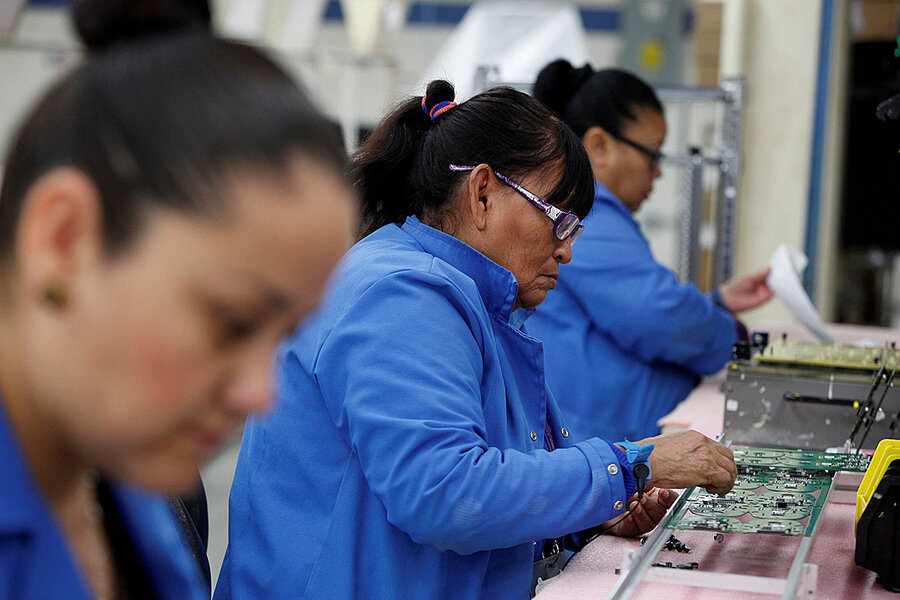Trade war roils US, China, but it means jobs for rest of Asia
Loading...
The U.S.-China tariffs and trade disputes are expected to dampen economic growth globally, but there are signs it could be a boon for developing nations such as Vietnam, the Philippines, and even Mexico. That’s because corporations are weighing shifting their supply chains out of China – in part or completely – to evade an expanding regime of tariffs.
“Many companies were already looking into this, and the trade war is giving them the final push to make it happen,” says Jon Cowley, a trade expert at the Baker McKenzie law firm in Hong Kong. A recent survey of U.S. companies operating in China in 2018 found that about one-fifth have moved or are considering moving capacity outside of China. Tariffs were the top reason, followed by rising costs and expectations of slower growth.
Already production in “footloose” industries such as apparel has been shifting. Mary Lovely, a Syracuse University economist, says that moving production of things like computers out of China is harder because “the Chinese are shoulders beyond what other parts of [developing] Asia can do.”
Why We Wrote This
Trade has long been an engine of rising prosperity for people in Asia’s developing nations. That’s still true, but the region faces a reshuffling amid fears that U.S.-China trade tensions will persist.
The California company Pedego Electric Bikes was long reliant on China as a production center. Now its bike assembly will be 100 percent in Vietnam and Taiwan.
The Taiwanese electronics firm Wistron is also moving its China-based production to new locations – much of it headed for a facility in the Philippines.
Two common themes tie these stories together: First, China has become less attractive for some manufacturers amid the rising tariffs of a U.S.-China trade war. Second, although the dispute can dampen economic growth globally, there are signs it could be a boon for developing economies in Mexico and Southeast Asia, where trade is an especially important driver of prosperity.
Why We Wrote This
Trade has long been an engine of rising prosperity for people in Asia’s developing nations. That’s still true, but the region faces a reshuffling amid fears that U.S.-China trade tensions will persist.
From fashion to machinery to electronics, many companies are weighing shifting production and supply chains – in part or completely – out of China to evade the expanding regime of tariffs. Even if a bilateral trade deal is reached, experts say it would be unlikely to fully resolve U.S.-China tensions, so this geographic rebalancing of global manufacturing could persist.
“Many companies were already looking into this, and the trade war is giving them the final push to make it happen,” says Jon Cowley, an expert in trade law with the Baker McKenzie law firm in Hong Kong.
Old jobs moving ... and new ones growing
Companies with global or regional footprints can evade tariffs by moving final production from China to another jurisdiction. If products are substantially transformed in the final location, the China origin label can be changed. Technology, machinery, and chemical industry firms affected by U.S. tariffs are making such moves, and others are expected to follow as U.S. tariffs broaden, Mr. Cowley says.
Developing countries in Asia are seeing a surge in investment, a further indication that companies are shifting production. Chinese and U.S. equity investment in new projects – known as “greenfield investment” – rose sharply in other developing Asian nations in 2018: China’s nearly tripled, and that of the U.S. surged 71 percent, according to the Asian Development Bank (ADB).
Such trends are expected to continue as trade wrangling between the U.S. and China becomes the new normal, economists and trade experts say.
“In the long run, if the conflict persists we may see increasing trade and production redirection away from China toward other countries that aren’t subject to the tariffs. The effects of this trade and production redirection will be positive for the rest of developing Asia,” says Abdul Abiad, an economist who directs the research and regional cooperation department at the ADB.
A recent survey of U.S. companies operating in China in 2018 found that about one-fifth have moved or are considering moving capacity outside of China. The top reason cited for doing so: U.S. tariffs on goods exported from China, followed by rising costs and expectations of slower growth, according to the business climate survey released in February by the American Chamber of Commerce in China.
Of those moving, 40% were heading to developing Asia, 11% to developed Asia, and 10% to Mexico. Mexico’s annual trade surplus with the United States surged by 15% to a record high of $82 billion in 2018, and some Chinese manufacturers have begun relocating to Mexico to escape U.S. tariffs.
“The trade war [and related uncertainty] has made what was a ‘plan B’ for some companies a ‘plan A’ for many,” says Scott Kennedy, a China expert at the Center for Strategic and International Studies.
Shoes more mobile than computers
Already production of shoes, apparel, toys, and other “footloose” industries has been shifting from China to Vietnam and other countries, partly due to rising wages in China, says Mary Lovely, a professor of economics at Syracuse University.
Moving mid-level manufacturing in items such as computers out of China is harder because it is more knowledge-intensive. With a relatively young, literate, and numerate workforce, “the Chinese are shoulders beyond what other parts of Asia can do,” Professor Lovely says.
Supply chains are “sticky,” and moving them requires a significant investment, Mr. Cowley says. Tariffs are only one variable firms weigh, with others being proximity of markets and suppliers, logistics costs, and workforce reliability. But the longer tariffs are in place, the more willing companies are to bear those costs, he says.
“This entire trade war has spurred more investment” in roads and other infrastructure aimed at paving the way for increased production in Vietnam and elsewhere in Southeast Asia, he says.
In another key ripple effect, American companies in China are being buffeted by the trade winds – vulnerable to paying more both for imported U.S. supplies and for products exported to the U.S. Raising their sales prices will hurt their competitiveness.
This is significant, because majority-owned affiliates of U.S. multinational enterprises in China sell far more goods and services in China’s domestic market – $286 billion as of 2016, the latest year for which data are available – than the U.S. exports in goods and services to China ($170 billion in the same year).
“American companies are selling a lot in China, and those jobs do support jobs in the U.S. Those profits do come to U.S. owners of the businesses,” says Professor Lovely. “It’s very cavalier to say we will let them hang in the wind while we pursue the trade war.”
Global effects of trade war
Overall, trade wars are economically harmful – especially for the countries waging them, economists say. Trade increases a country’s wealth, measured by gross domestic product (GDP). Trade allows resources to move across borders to where they are used most efficiently. When barriers to trade are imposed, such as tariffs – a tax on imports – they reduce GDP.
Both the U.S. and China are projected to face economic damage if current tariffs stay in place for the rest of 2019 and 2020, according to the ADB. China is expected to be hit hardest, with a 1.03% reduction in GDP, while the GDP of the U.S. will be 0.20% lower than if the tariffs were not in place, the ADB estimates. World GDP is also projected to fall by 0.15%.
The loss in GDP will mean job losses – with China expected to lose 1.76 million jobs and the U.S. 194,000 in 2019 and 2020, under the scenario envisioned by the ADB.
“We see a few people helped, a lot more people hurt, and no accountability in what we are doing with this kind of redistribution,” says Professor Lovely.











